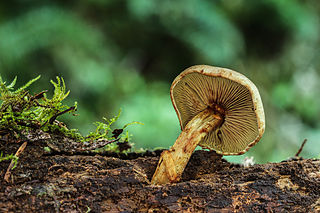
Gymnopilus junonius is a type of mushroom-forming fungus in the family Hymenogastraceae. Commonly known as the spectacular rustgill, this large orange mushroom is typically found growing on tree stumps, logs, or tree bases. Some subspecies of this mushroom contain the neurotoxic oligoisoprenoid gymnopilin.

Gymnopilus is a genus of gilled mushrooms within the fungal family Hymenogastraceae containing over 200 rusty-orange spored mushroom species formerly divided among Pholiota and the defunct genus Flammula. The fruit body is typically reddish brown to rusty orange to yellow, medium to large, often with a well-developed veil. Most members of Gymnopilus grow on wood but at times may appear terrestrial if the wood is buried or decomposed. Members of Pholiota and Cortinarius are easy to confuse with Gymnopilus. Pholiota can be distinguished by its viscid cap and duller spores, and Cortinarius grows on the ground. Beginners can confuse Gymnopilus with Galerina, which contains deadly poisonous species.

Gymnopilus luteofolius, known as the yellow-gilled gymnopilus, is a large and widely distributed mushroom that grows in dense clusters on dead hardwoods and conifers. It grows in late July to November in the east and in the winter on the west coast of North America. It has a rusty orange spore print and a bitter taste.

Gymnopilus sapineus, commonly known as the scaly rustgill or common and boring gymnopilus, is a small and widely distributed mushroom which grows in dense clusters on dead conifer wood. It has a rusty orange spore print and a bitter taste. This species does not stain blue and lacks the hallucinogen psilocybin.

Gymnopilus validipes is a mushroom in the family Hymenogastraceae. It is widely distributed in North America and Europe.

Gymnopilus braendlei is a species of agaric fungus in the family Hymenogastraceae that contains the hallucinogens psilocybin and psilocin. It was originally described by mycologist Charles Horton Peck as Flammula braendlei, from specimens found in the District of Columbia in 1902.
Gymnopilus abramsii is a species of mushroom-forming fungus in the family Hymenogastraceae. It was first described by American mycologist Murrill in 1917. The epithet abramsii commemorates LeRoy Abrams.
Gymnopilus areolatus is a species of mushroom-forming fungus in the family Hymenogastraceae. It was first formally described by American mycologist William Alphonso Murrill, from specimens collected in Cuba.

Gymnopilus bellulus is a species of mushroom in the family Hymenogastraceae. It was given its current name by American mycologist Murrill in 1917. It is odorless, bitter in taste, and regarded as inedible.
Gymnopilus earlei is a species of mushroom in the family Hymenogastraceae.
Gymnopilus fuscosquamulosus is a species of mushroom-forming fungus in the family Hymenogastraceae.

Gymnopilus humicola is a species of mushroom in the family Hymenogastraceae.

Gymnopilus ventricosus, commonly known as the jumbo gym, is a species of mushroom in the family Hymenogastraceae. It was first described from the Stanford University campus by Franklin Sumner Earle as Pholiota ventricosa in 1902.
Gymnopilus rufobrunneus is a species of mushroom-forming fungus in the family Hymenogastraceae.

Gymnopilus punctifolius is a species of mushroom in the family Hymenogastraceae found in North America.
Gymnopilus praelaeticolor is a species of mushroom in the family Hymenogastraceae.
Gymnopilus praefloccosus is a species of mushroom in the family Hymenogastraceae.
Gymnopilus pholiotoides is a species of mushroom in the family Hymenogastraceae.

Gymnopilus luteocarneus is a species of mushroom-forming fungus in the family Hymenogastraceae.
Gymnopilus lutescens is a species of mushroom-forming fungus in the family Hymenogastraceae.










